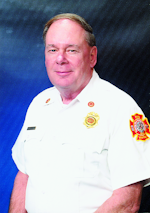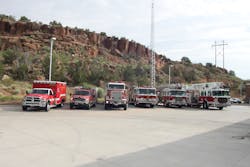Hazmat Studies: Introducing the LANL Hazmat Challenge
Los Alamos National Labs (LANL) is located in Los Alamos County, in north-central New Mexico. It was founded in 1943 during World War II as Project Y, serving as a secret facility for research and development into the first nuclear weapon. It took just 20 months. On July 16, 1945, the world's first atomic bomb was detonated 200 miles south of Los Alamos at Trinity Site on the Alamogordo bombing range. The Trinity Site was designated a National Historic Landmark in 1975. Had it not been for the Manhattan Project, Los Alamos—aka “Atomic City”—may not have existed.
Today LANL’s core mission remains “assuring the safety and reliability of the nation's nuclear deterrent.” LANL maintains the nation's nuclear weapons stockpile and reports annually to the president on its status. It also conducts a variety of research, including but not limited to nuclear nonproliferation and border security, energy and infrastructure security, and counter measures to nuclear and biological terrorist threats. Recent achievements and research breakthroughs include hydrogen fuel storage, unlocking biomass, converting carbon dioxide to fuel to combat climate change, converting weapons-grade plutonium for use in nuclear power, and creating a powerful laser to protect Navy ships from incoming missiles.
Fire protection
LANL fire protection is provided by the Los Alamos County Fire Department (LAFD), an ISO Class 2 department and the second-largest fire department in the state of New Mexico. Under the command of Chief Troy Hughes, LAFD also provides fire protection to the communities of Los Alamos and White Rock along with response to an extensive wildland/urban interface, as the county is located in the Santa Fe National Forest. LAFD covers an area of 100 square miles, half of which is national forest and county and the other half is LANL.
LAFD was organized in 1943 under the Manhattan Project, with seven civilian firefighters and 25 volunteers. In September 1943, the department was taken over by the military. The fire department was governed by the U.S. Atomic Energy Commission and the U.S. Department of Energy until 1989, when the incorporated County of Los Alamos took over the fire department.
Today, LAFD operates out of six fire stations with a force of 139 shift firefighters, three shift battalion chiefs, nine chief and staff officers assigned to day shifts, and 11 civilian staff. Shift firefighters work 48 hours on and 96 hours off. They operate six paramedic engines, one truck, one rescue unit, one hazmat unit, one CFR unit and six paramedic units. Engines 1, 4 and 6 are equipped with 50-foot booms. Five mini-tenders and three large tenders are utilized for wildland firefighting and cross-staffed by on-duty personnel. Over the past four years, LAFD has obtained a new hazmat response vehicle and upgraded personnel training and equipment for hazmat response.
LANL operates its own hazardous materials response and hazardous device teams staffed by LANL employees and operated by the Emergency Operations Division, Emergency Response Group. LANL and LAFD hazmat teams respond to all hazmat incidents and work closely together to handle incidents at LANL. The lab team will also respond when needed throughout Los Alamos County.
Challenge origins
LANL’s Emergency Operations Division has organized and presented an annual Hazmat Challenge for nearly 20 years. When LANL first formed its Hazmat Team in the early 1990s, they sent response personnel to the California Specialized Training Institute (CSTI) for training and certification. In an effort to minimize training costs, LANL developed its own training center at Technical Area 49. Two of their personnel were certified as outreach instructors for CSTI. Other local response agencies became aware of the LANL hazmat training facility and training props, and inquired about the possibility of training along with LANL personnel.
Following training sessions at LANL, several local teams decided to hold a hazmat-focused competition. The result was the first Hazmat Challenge, held on June 18, 1997. Four teams participated in the first challenge, which was a one-day event with four scenarios and a Level A obstacle course. The Area 49 training center was eventually built up to CSTI standards and certified as a CSTI Training Center.
Plans for the future have included the possibility of a second location for the Hazmat Challenge at the Edmond, OK, Fire Department. If it comes to pass, the plan is to alternate the challenge between the two sites. Having the challenge in Oklahoma on alternate years will allow the opportunity for more teams from the Midwest to participate.
According to challenge coordinator Chris Rittner, "The challenge provides hazardous materials responders the opportunity to test their skills, share best practices with other response agencies, and learn new techniques through realistic hazardous materials release scenarios in a safe, non-hazardous environment.”
The Hazmat Challenge is currently limited to 16 teams. Teams typically come from National Guard Civil Support Teams (CST), other national laboratories, state and regional response teams and fire departments. The winning team receives a "traveling trophy" and the top-scoring teams in the technical and overall categories are awarded permanent trophies.
Technical areas
Hazmat Challenges have traditionally been held at LANL Technical Area 49, but for the first time in 2015, a second facility was added to the competition—Technical 16, which provided a facility for indoor scenarios.
Technical Area 49 contains outdoor training props used for training LANL personnel, personnel from other federal agencies, and state and local response personnel. Some of the fixed props at Area 49 include the following:
- Pipe and Valve Tree: This is a plumbing simulator on which responders can exercise skills and techniques for mitigating pipe leaks, valve failures and replacements and other plumbing- and piping-related scenarios.
- Chlorine/Gas Cylinder Trainer: A portable prop for training on responses to chlorine, sulfur dioxide and other compressed gasses. This prop allows for training on 100-lb., 150-lb., and 1-ton containers.
- Confined Space: This prop allows LANL to test confined-space skills, as well as response and rescue operations. The interior can be configured in several ways, including vertical entry, side entry, use of theatrical smoke to obscure vision, and mechanical skills, such as valve and switch operation and piping scenarios.
- Rail Car: Designed for the hazmat technician and specialist courses, this prop is a standard rail tank car that has been retrofitted with the four most common service domes currently found in use. A number of scenarios can be simulated that allow training on mitigation of acid leaks, chlorine releases, as well as liquid petroleum gas (LPG) and general cargo leaks.
- Underflow/Overflow: This prop allows responders to practice skill related to watercourse protection in the event of a material release. With the tank truck the use of dome clamps, product identification and construction of different types of dams, dikes and retention structures can be exercised to control the flow of material threatening a watercourse.
- MC306: This is a standard low-pressure liquid transport trailer used to train for transportation accidents. The typical scenario involves a trailer transporting flammable liquids, such as fuels or other petroleum products. Responders practice assessing, stabilizing and breeching the compartments in the trailer to safely off load material. Techniques practiced here include patching, plugging and Stringer operations.
- Clandestine Laboratory Building: This structure allows the construction of a number of simulated clandestine laboratory scenarios from drug manufacturing to bio-agent manufacturing. Responders can practice size up and entry consideration protocols, as well as assessment, sampling and mitigation techniques associated with scenarios.
- Standard Box Truck: This provides the opportunity to practice a wide variety of transportation scenarios from the standard cargo truck to radiological transportation issues.
- Decontamination Pool: This pool serves as a tool for practicing decontamination techniques and trying out new decon tools. It also serves as a challenging station in the obstacle course, which is part of the annual Hazmat Challenge.
- Other Tools: There are other structures, areas and tools, such as a large steel building with internal rooms, Conex transportainers, robots and an explosives pad that allow for customized training for a wide array of scenarios and needs.
Technical area 16 is an indoor facility that has props that simulate the inside of buildings, such as clandestine drug and chemical and biological agent manufacturing labs. It can also be set up for other scenarios, such as those involving radioactive materials. During the 2015 Hazmat Challenge a firing range in Area 16 was also used to set up a prop simulating an underground terrorist clandestine manufacturing operation. Area 16 is a secure facility and photographs are not allowed there.
2015 Challenge
The 2015 Hazmat Challenge included teams from three states—New Mexico, Missouri and Nebraska. The first two days of the weeklong event were filled with optional training and continuing education opportunities for participants. Subjects presented by LANL staff included anhydrous ammonia, chemical/biological agents, air monitoring and radiation for first responders.
Following the two days of training, the competition began with eight hazardous materials and WMD scenarios lasting 30 minutes each. Four scenarios were conducted at each technical area, and teams rotated between the two. On the final day, teams rotated through a scenario-based Level A obstacle course at Technical Area 49. Scoring for the competition is based upon CFR 1910.120 standards and NFPA 472: Standard for Competence of Responders to Hazardous Materials/Weapons of Mass Destruction Incidents.
More info
Part 2 of this article will focus on the scenarios and obstacle course events of the 2015 Hazmat Challenge along with the final results of the competition. For questions or additional information, contact Jeff Dare at LANL: (505) 665-5511 or [email protected].

Robert Burke
ROBERT BURKE, who is a hazardous materials and fire protection consultant and a Firehouse contributing editor, is a Certified Fire Protection Specialist (CFSP), Fire Inspector II, Fire Inspector III, Fire Investigator and Hazardous Materials Specialist. He has served on state and county hazmat teams. Burke is the author of the textbooks "Hazardous Materials Chemistry for Emergency Responders," "Counter-Terrorism for Emergency Responders," "Fire Protection: Systems and Response," "Hazmat Teams Across America" and "Hazmatology: The Science of Hazardous Materials." He can be contacted at [email protected].






